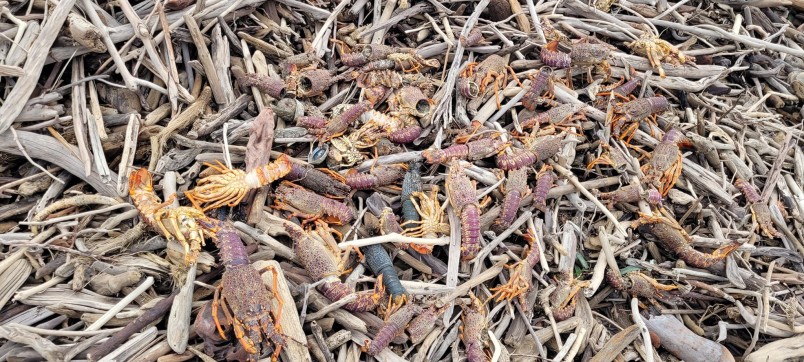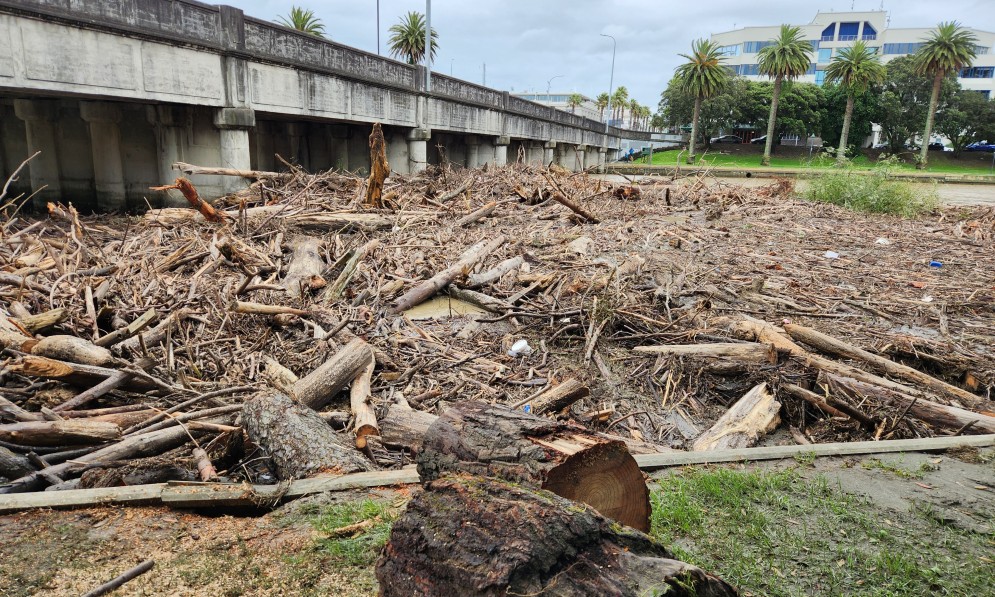Repeated devastation caused by forest slash must end. We need to find solutions to stop woody waste ending up in local waterways. By Caroline Wood
Forest & Bird magazine
A version of this story was first published in the Autumn 2023 issue of Forest & Bird magazine.

Forest & Bird was part of concerted efforts to pressure the government to hold an independent inquiry into forestry waste, following devastating storm damage across the North Island caused by ex-Cyclone Hale and Cyclone Gabrielle.
Tonnes of logs, woody debris, and mud from poorly managed plantation pine forests came crashing down Tairāwhiti hillsides into rivers and the ocean.
A young Wellington boy was killed in late January after being struck by some of the forestry slash washed up on to Waikanae Beach, in Gisborne.
Locals called it an ecological and community disaster, and the Environmental Defence Society demanded an independent inquiry into forestry practices and the rules surrounding the disposal of woody waste.
Forest & Bird’s Gisborne Branch chair Grant Vincent said: “In recent years, the logs, slash, and mud from poorly managed plantation forests have caused a series of unmitigated ecological disasters in the Tairāwhiti region.
“I remember the first erosion/slash incident nearly 30 years ago, in the Wharerata hills area south of Gisborne. Since 2012, with fairly monotonous regularity, we have seen the problem spread across our wider district.
"Erosion has disastrous effects on our coastal marine environment."
“It is by no means the only land use problem here in Tairāwhiti. There is still a big and ongoing problem with erosion on pastoral farmland washing out to sea. This has disastrous effects on our coastal marine environment.”
Local advocacy group Mana Taiao Tairāwhiti, which includes farmers and horticulturalists, Māori landowners, and conservationists, launched a local petition calling for a reduction in the amount of sediment and forestry slash entering waterways.
It says an independent inquiry would be a good way to move from the “blame game” to objectively identifying what has gone wrong and make the appropriate policy changes.
“We are sick of seeing the carnage created by forestry slash in our awa and along the coast,” said spokesperson Hera Ngata-Gibson, who is based in Anaura Bay with whānau in Uawa.
“What’s happening here in Te Tairāwhiti is an ecological disaster. It’s time we all hear and acknowledge what our environment is screaming at us. Enough is enough!
“We all have a part to play in sorting this huge issue. We must speak up and put the wellbeing of our whenua above all else. It’s critical for our own longevity and wellbeing in this place.”

Crayfish and paua washed ashore after the January storm, Ruatoria/Waiapu, north of Gisborne. Image Graeme Atkins
The Environmental Defence Society, which led calls for an independent inquiry, said it was clear there had been a “serious failure of public policy”.
“The cycle of environmental damage caused by plantation forestry operations must stop,” said its CEO Gary Taylor. “It is time to rein in damaging planting and harvesting practices with a fundamental reset of the rules that govern the sector.”
“It’s shocking that lessons from the previous storms and flooding aren’t being learned,” said Nicola Toki, Forest & Bird’s chief executive.
Professor Euan Mason, of the University of Canterbury’s School of Forestry, called for a review of land use on the East Coast, including forest harvesting operations, slash movement, and erosion.
“Climate researchers report that cyclones are likely to increase in frequency and ferocity as the world warms, so we must re-examine our behaviour and respond appropriately, particularly on such fragile sites,” he said.
Forest & Bird's Grant Vincent at Pamoa Forest, a former radiata pine forest being regenerated into native forest. Image Barry Foster
Forest & Bird’s Gisborne Branch secretary Barry Foster says all land users need to adopt best practices for keeping woody debris from waterways.
“Some forestry companies are not doing things like ensuring debris are removed from steep hillsides and building slash catchers to prevent dead logs from entering waterways,” he said.
“While radiata pine slash is the major part of the problem, debris from other tree species from farms and native bush are found in waterways as well.”
In February, the government announced a ministerial inquiry into forestry practice and slash. It will be led by former National Party minister Hekia Parata, who lives in Gisborne, along with former regional chief executive Bill Bayfield and forestry engineer Matthew McCloy.

